

The Chubb Archive is part of The History of Locks Museum Resources
Contact our curator for more information
© 2004 - 2016

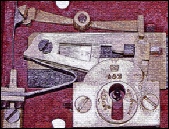
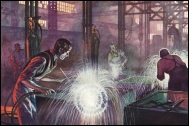
Your one-stop resource for dating & information on vintage and antique Chubb Locks, Safes & Security Equipment
Chubb - Office Locations and More Recent History
Head Office & Branch Locations
The London Office remained at 57 St. Paul's Churchyard until the need for larger premises prompted a move to 128 Queen Victoria Street in 1877. Five years later Chubb and Sons Patent Lock and Safe Manufacturers received their ‘Letters of Incorporation’ and this address became the Head Office for Chubb and Sons Lock and Safe Co. Ltd.
The Company had a Branch Office in Liverpool in 1841 (see photographs).
By 1926 there were Sales Offices at 39 Aldwych, London WC2 and 68 St. James's Street, London SW1 along with Branch Offices in Manchester, Liverpool, Glasgow and Edinburgh.
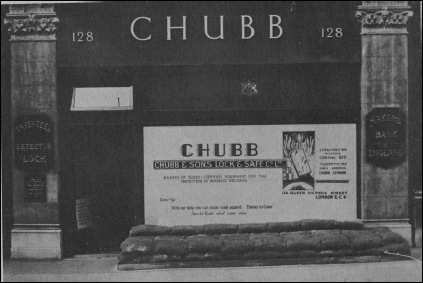 The premises in Queen Victoria Street were badly damaged during an Air Raid on the night of May 10th/11th 1940. At the start of the Blitz, fire watch teams had been drawn up to take care of nos. 124 - 134 Q. V. Street. Each night a team of four would be on duty. On this particular night, one team member had received his ‘call-up papers’ and unable to recruit a replacement at short notice, the team were down to three watchers, Mr. J. Henshilwood (Chubb & Sons), Mr. Walker and Mr. Green.
The premises in Queen Victoria Street were badly damaged during an Air Raid on the night of May 10th/11th 1940. At the start of the Blitz, fire watch teams had been drawn up to take care of nos. 124 - 134 Q. V. Street. Each night a team of four would be on duty. On this particular night, one team member had received his ‘call-up papers’ and unable to recruit a replacement at short notice, the team were down to three watchers, Mr. J. Henshilwood (Chubb & Sons), Mr. Walker and Mr. Green.
The account of events from the initial warning at 10.57pm to the ‘all clear’ some six hours later is too lengthy to relate here. Suffice to say that in total, over 400 tons of bombs were dropped on London that night and although none of the HE Bombs scored a direct hit, two in the immediate vicinity around 11pm caused a major fire around the building. This was eventually put out by the Fire brigade even though the raid continued non-stop. Around 4am 12 HE bombs crashed down on the north side of Cannon street creating a huge fire extending from St. Paul's to the General Post Office.
The premises in Queen Victoria Street were badly damaged during an Air Raid during the night of May 10th 1940 forcing temporary relocation in 68 St. James's Street. The late 1940's saw a rapid growth in business and the Head Office moved to 40-42 Oxford Street, W.1. The early 1950's saw yet another move, to 175-176 Tottenham Court Road but by 1959 these offices were too small and in 1960, the Company moved to 14-22 Tottenham Street W.1.
 The fires spread to the south side of Cannon Street and together with those that had begun at the east end of Q. Victoria Street, crept towards the Chubb Building. A change in the wind direction made it seem as though the building might be spared but within an hour the direction changed again and the fires crept closer. By this time the water supply had run out and it took some time to establish a new feed from the river. Having done this the supply pipe burst as soon as the hoses were turned on and the flames succeeded in enveloping the building which burned throughout the day! Without electricity or gas supplies since just after 11pm, the watchers spent the night either sheltering from the HE bombs (difficult when you are on the roof) or dashing about with stirrup pumps trying to extinguish fires started by flying embers which rained down for most of the night.
The fires spread to the south side of Cannon Street and together with those that had begun at the east end of Q. Victoria Street, crept towards the Chubb Building. A change in the wind direction made it seem as though the building might be spared but within an hour the direction changed again and the fires crept closer. By this time the water supply had run out and it took some time to establish a new feed from the river. Having done this the supply pipe burst as soon as the hoses were turned on and the flames succeeded in enveloping the building which burned throughout the day! Without electricity or gas supplies since just after 11pm, the watchers spent the night either sheltering from the HE bombs (difficult when you are on the roof) or dashing about with stirrup pumps trying to extinguish fires started by flying embers which rained down for most of the night.
The 300 women and children sheltering in the basement of the building next door had to be evacuated when the block caught fire.
In Chubb’s basement there were two strongrooms, one of brick construction with an old ‘C’ quality Door and the second (of more recent 18” concrete construction) with a Standard Quality Door. These were opened several days later and although surrounded by red hot debris, both preserved their contents in excellent condition. For the rest of the War, Head Office moved to the sales office at 68 St. James’s Street.
The late 1940's saw a rapid growth in business and Chubb’s Head Office moved to 40-42 Oxford Street, W.1. leaving the Banks Division at 128 Q V St. With business continuing to grow, personnel numbers in Head Office increased and the early 1950's saw another move, this time to 175-176 Tottenham Court Road. By 1959 these offices were too small and in 1960, the Company moved to Totfield House, 14-22 Tottenham Street W.1.
128 Queen Victoria Street, London - early 1940
EARLY SALES HISTORY / OFFICE LOCATIONS / THE CHUBB GROUP / LAST 25 YEARS
Chubb Overseas
Soon after the Company was founded they began sending products overseas. The safe for the Victoria Railway Co. and the lock referred to in the ALCA journal are just two examples. Some years ago while looking for records of a safe shipped to Australia in the early 1850s, I came across details of other safes ordered by customers overseas.
It wasn’t until the latter part of the 19th century that Chubb staff began travelling overseas. Mr. R.G. Maxwell visited South Africa in March 1890 to promote sales of locks and safes. Due to the success of that trip he returned the following year to live permanently in Cape Town ; opening a depot to import Chubb products he also traded a wide range of building & plumbing materials under the name of Chubb and Maxwell Ltd. In 1897 it was decided to expand this business by setting up agencies and shops in other major South African towns. That
same year Chubb’s Australian Company was founded in Sydney to control the distribution of the full range of products throughout Australia. By 1926 sales had grown enough for Chubb to open a manufacturing plant in Sydney.
As early as 1879, the Chairman, George Hayter Chubb, visited America to study the latest security developments.
In a letter to his brother John sent from Washington in May, he mentioned some of the things that impressed him most in American business life. Telephones in every office of decent size, the use of Fire Alarm Posts on the streets of New York and the business operated by a Company named Holmes on Broadway:
“It is something like the telephone arrangements but is only for Fire and Burglar Alarms; all the calls come to their office where two armed watchmen are on duty at all times and have immediate communication with the Police and Fire Dept's. I am going to get all the information I can . . .“
On returning to London he found the Telephone Company of London had just been set up and lost no time in becoming a subscriber - the telephone number was London 9.
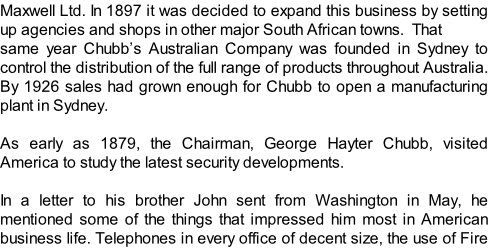


Chubb Works, Sydney
REAR OF 128 QUEEN VICTORIA ST. A FEW DAYS AFTER 10TH MAY 1940
Building the ‘Chubb Group’
The following UK Companies were acquired between 1956 and 1965:
1956 - Hobbs Hart & Co. Ltd. (founded by A.C. Hobbs c1851)
1958 - Chatwood-Milner Ltd.
1961 - The International Coin Counting Machine Co.
1962 - Burgot Alarms Ltd and Rely-a-Bell
1964 - Read and Campbell Ltd. (Fire Extinguishers)
1965 - Josiah Parkes and Sons (Holdings) Ltd. ("UNION" locks)
1967 - Pyrene Company Ltd. (Fire protection and detection systems)
Developments Overseas :
1950 Manufacture of Chubb security equipment began in South Africa with the establishment of Chubb and Sons Lock and Safe Company (SA) (Pty) Ltd., succeeding Chubb & Maxwell Ltd.
1954 Chubb began manufacturing in Canada.
1957 The Chubb Lock and Safe Company of Rhodesia (Pvt) Ltd. was formed to manufacture and distribute security products in that Country
1960 In Canada a merger of the two largest safe manufacturers resulted in the formation of Chubb-Mosler and Taylor Safes Ltd.
1962 The Chubb Lock and Safe Co. Ltd. was formed in New Zealand to manufacture and market security products.
1967 Formation of NV Chubb Fraigneux SA, Belgium
During the 1970's the Group's turnover grew steadily; the gradual increase in staffing levels at London Head Office eventually forced the re-structuring of various administration departments and a search for new Group Headquarters.
 The new Chubb Group corporate ‘logo’ pictured here was introduced during the 1970s and the Lock Division made full use of the new logo in a radical update of product packaging, catalogues and other sales promotion material. They also began national and regional advertising in the press and on TV. At the same time their commercial outlets were offered an illuminated logo sign bearing the title ‘CHUBB CENTRE’ providing they maintained a certain level of specified products. By the early 1980s there were CHUBB CENTRES throughout the UK.
The new Chubb Group corporate ‘logo’ pictured here was introduced during the 1970s and the Lock Division made full use of the new logo in a radical update of product packaging, catalogues and other sales promotion material. They also began national and regional advertising in the press and on TV. At the same time their commercial outlets were offered an illuminated logo sign bearing the title ‘CHUBB CENTRE’ providing they maintained a certain level of specified products. By the early 1980s there were CHUBB CENTRES throughout the UK.
In 1980 the Group Directors and various Central Administration Depts. re-located to The Manor House at Feltham, Middx. And Chubb & Sons Lock & Safe Co.Ltd. left Tottenham Street, moving to smaller but newly constructed offices at Fountain House in Whitfield Street W.1.
Racal Electronics Group
There is a wonderful ‘story’ as to why Racal Electronics decided to make a bid for the Chubb Group in the early 1980s. The ‘story’ is that Racal thought these countrywide premises were for monitoring Chubb Alarm installations within their local area and therefore ready made electronic communication centres. It must have been a shock to discover the real business behind the sign!
Although the Group Board did their best to defeat the takeover, Chubb became part of Racal Electronics in 1984. During the two years following the take-over, all Inner London Offices were closed. Many staff were made redundant, some were re-located to various Outer London offices and others to Wolverhampton. The Manor House at Feltham closed in the late 1980's and the West End property at 68 St. James's Street was sold. Considering its location the price must have been enormous.
Wednesfield Road, Wolverhampton became the base for the Lock and Safe operations. Separate lock and safe divisions with the names Chubb Lock Company and Chubb Safe Equipment Company were established, each with their own Senior Management.
In 1988 Chubb Lock Co. became Racal-Chubb Products Ltd. , to reflect an expansion in the range of Chubb branded security products. These included items such as portable fire extinguishers, security lights and protective clothing. At the same time, plans were set in motion to create a dedicated manufacturing unit (see below) for safe locks and the range of contract locks produced for the Post Office, Prison Establishments and Her Majesty’s Stationery Office, all of which had until then, been built in the Lock Works as part of the Lock Company’s enormous range of products.
Chubb High Security Locks
As well as selling to business and residential customers, from the founding of the Company in 1818, Chubb Locks were used on their safes and all subsequent products manufactured in the safe factory. In addition, Chubb produced high security locks for 'special' clients. In 1856 following the introduction of the newly designed Pillar Box, the General Post Office asked Chubb to produce Locks for their Letter Boxes. To date, the Company still supplies the Locks for Pillar, Wall and Lamp Letter Boxes.
The Chubb Leg Irons found in the Horseley Fields building confirm the Company's early production of Detention Equipment . There are records in the Archive detailing orders from various ‘Houses of Correction’ in England, many dating from the 1820s & 30s. Most were for padlocks since they were the preferred ‘lock’ in those days but it wasn’t long before Chubb produced a Cell Door Lock.
In a paper John Chubb presented to a meeting of the Institution of Civil Engineers on 9th April 1850, he included a letter from the Governor of Westminster Bridewell, which praised the performance and security of Chubb Prison Locks. According to papers in the Archive, during the last half of the 19th century, Chubb Prison locks were being exported to many Empire Countries .
In 1995, whilst working in the far east on a contract at a newly constructed prison , I was astonished to find Chubb cell locks and keys dating from 1895, still in use at the capital city’s Central Prison.
From 1900 - 1950 demands for these 'Contract Products' increased slowly but the introduction of new prison locks for H. M. Prison Dept in 1960 and increasing requirements during the '60's and '70's from the various other 'special clients', while good for business, resulted in tremendous pressure within the Lock Works.
By the mid 1980's there were major difficulties in meeting delivery dates, due to commercial locks having precedence in terms of capacity in the production and assembly depts. The decision to create a separate 'High Security Locks' section within the existing Lock Works was taken in early 1988.
Over the next 6 - 9 months production and assembly areas were laid out and administrative offices constructed. April 1989, saw the launch of Chubb High Security Locks as a separate trading division of Chubb & Sons Lock & Safe Co. Ltd.
Chubb Security plc
In 1992 Racal fought off Williams’ first bid by de-merging their Telecoms and Chubb Divisions.
The Chubb Companies were floated on the London Stock Exchange as Chubb Security plc whose Head Office was based at Chubb House, Sunbury-on-Thames, Middx.
Chubb Fire Security were also based at this address but Chubb Alarms Ltd. remained a short distance away in Walton-on-Thames.
At Wolverhampton, Chubb Locks Ltd. replaced Racal-Chubb Products Ltd.
Chubb High Security Locks continued to enjoy a steady expansion in trade at home and overseas but faced with increasing competition, Chubb Safe Equipment Co. were finding it harder each year to achieve annual sales targets. The need to reduce costs and improve efficiency forced them to issue a series of redundancy notices in '92 & '93.
When Josiah Parkes & Sons (Holdings) Ltd. had joined the Chubb Group in 1965 it was agreed they would continue trading from their original headquarters in Willenhall, Wolverhampton, selling the long established and respected range of UNION locks. In 1996 Chubb Locks Ltd. announced their intention to move all manufacturing and assembly to Parkes’ factories in Willenhall. To minimise disruption the transfer of machinery and staff took place over a two year period and the exercise was completed in Sept. 1998 when the Sales Staff and Directors moved into the Offices in Union Street.
Williams Holdings plc
On Feb.14th 1997 came the announcement that Chubb Security plc was now owned by Williams Holdings. 'The St. Valentines Day Massacre' in the eyes of some Wednesfield Road staff! Williams ownership lasted about 40 months but during those 3+ years they re-structured every Chubb Company throughout the world.
At Wednesfield Road, Sales and Admin Staff vacated the four storey office block at the front of the site, moving into new offices created within a building near No.4 Gate in Woden Road, originally used as a Customer Relations Centre. This adjoined the original Chubb Social Club and Works Canteen.
Williams had been determined to acquire Chubb despite their unsuccessful bid for Racal in 1991. Having purchased YALE in the late 1980's, the addition of CHUBB and UNION now put them in control of the best known brand names. The announcement in March 2000 that Williams plc were in discussion with Assa Abloy AB concerning the sale of YALE, UNION and the CHUBB Physical Security Divisions, certainly came as a surprise.
Assa Abloy AB
The sale was completed in August 2000. Assa Abloy being solely in the business of Lock Making, had no interest in Safes, Strongrooms, Security Screens etc. and these Chubb Security Divisions were quickly sold to Gunnebo AB, owners of Tann, Rosengren and Fichet-Bauche.
Illustration of the first GPO Letter Box in London
Located at the junction of Fleet St. and Ludgate Hill
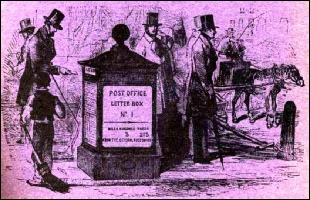
1930 catalogue illustration of
Chubb Cell Lock
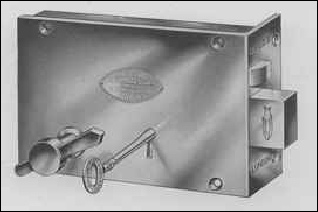
1940s Cell Lock
Picture by kind Permission of Mr. T. Watson
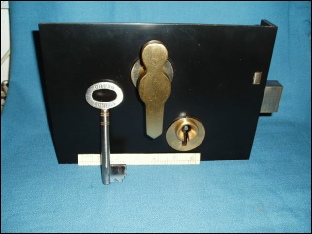
Chubb Prison Lock and keys - the mechanism is the ‘Improved Patent’ registered June 1824.
Picture by kind permission of Mr.S. Waterman
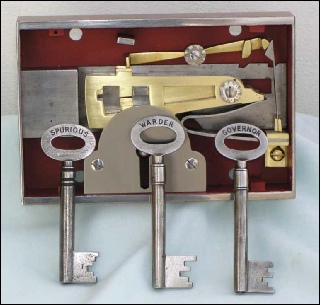
Home | Previous Page | ToP | Next Page
| Chubb 1818-1990s |
| Chatwood-Milner |
| Chubb Family |
| Early Sales/Offices/ChubbGroup/1980s & on |
| The Detector Mechanism |
| Photographs |
| Chubb Money Boxes |
| The Aubin Trophy |
| Lock Number 696 |
| Williams acqusition |
| Arthur Briant |
| Ibbs - Export is Fun |
| Peter Gunn |
| Back to Work |
| First Steps |
| My Export Career begins |
| The Happy Years |
| Export Manager |
| Back to The Midlands |
| Back to The Midlands - part 2 |
| Australia |
| The Midlands - again! |
| The Final Years |
| Conclusions |
| Slingsby Dart T51 Sailplane |
| Latest News |